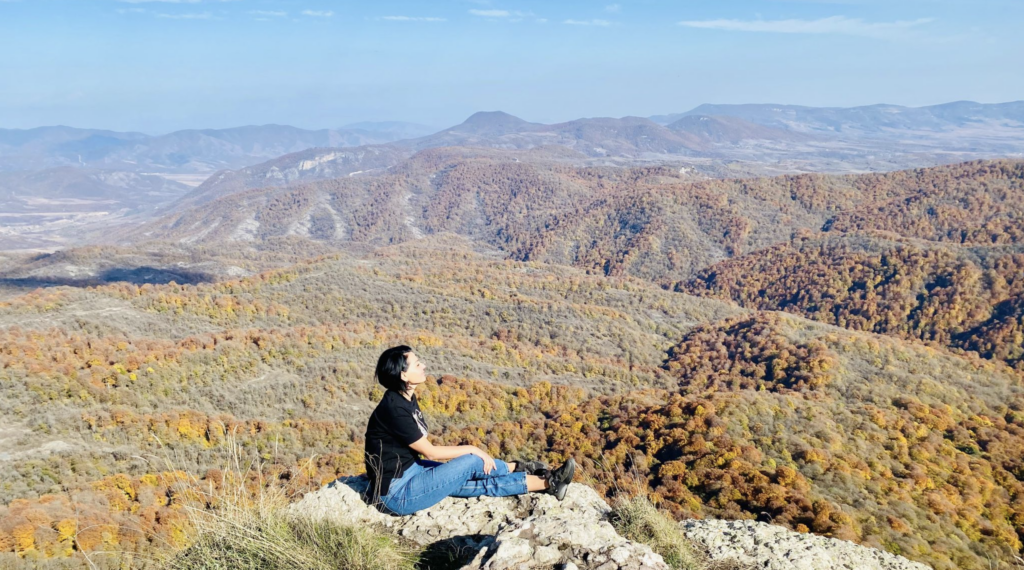Women's Rights & Issues
Related: About this forumA Freelance War Correspondent Covers Ethnic Cleansing of Her Indigenous Nation
(lengthy, depressing, horrifying article)
(interestingly, I just learned about this ethnic cleansing from Bill Penzey's email this morning)
A Freelance War Correspondent Covers Ethnic Cleansing of Her Indigenous Nation
10/22/2023 by Jackie Abramian
“This is history,” said Siranush Sargsyan of the genocide against 120,000 Armenians living in Nagorno-Karabakh. “This is also my story, my family story. I’m also the victim of the war that I report on.”

Days before Sargsyan’s September departure from Artsakh, standing at Renaissance Square, as thousands prepared for their exodus. “It was one of the hardest moment to witness.” (David Ghahramnyan)
For nearly three years, Siranush Sargsyan has documented Azerbaijan’s siege of the 120,000 indigenous Armenians in her disputed homeland of Artsakh (Nagorno-Karabakh). The former history teacher and state worker turned wartime freelance journalist is now among the over 100,700 forcibly displaced taking refuge in neighboring Armenia. “I’m the protagonist of the photos and articles I produce because I want to tell these stories. This is history. This is the reality we must show,” said Sargsyan, an Artsakh native, now living in the neighboring Republic of Armenia. “This is also my story, my family story. I’m also the victim of the war that I report on. This is also my reality and I show it with hopes to end the atrocities we endured.” Sargsyan, 39, has survived two major wars (1992-94 and 2020) while documenting Azerbaijan’s systematic ethnic cleansing of the disputed enclave. She has witnessed indiscriminate atrocities upon her people, and lost countless family members, acquaintances, classmates and teachers. She lived through the Azerbaijan-imposed starvation campaign for nearly 10 months—which sealed off Artsakh from the outside world, cutting off electricity, food, gas and medical supplies.
Azerbaijan’s final offensive, under the guise of “anti-terrorist activities” on Sept. 19 brought further bombing to the besieged civilians across Artsakh. Sargsyan’s social media posts showed weary residents sheltering in basements, scenes of barraged apartment buildings, and a haunting image of a mother and child clinging together (distributed via AP). In her BBC article on a traumatized mother whose 8- and 10-year-old sons were victims of the bombing, she detailed a mother’s insistence to transport her children’s remains to Armenia for burial. “When the Sept. 19 bombardment started, I first rushed into a basement shelter, then soon walked out and started to video the distant smoke from the bomb blasts, the silence and the voices. The neighborhood’s bombed buildings haunted me the most—I walked the backyards under the sky-high laundry lines the women proudly hung.” said Sargsyan. Her footage of backyard laundry lines flapping in mid-air between high-rise buildings was among her last from Artsakh.
. . . . .

November 2022 at Kachaghakaberd (magpie) Mountain Top Fortress, named for its inaccessibility since only magpies could reach to the mountain top. (Courtesy of Siranush Sargsyan)
. . . .
Her mission to amplify the stories of those “still alive and struggling” brought her to a six-day training initiated by the AGBU Young Professionals of Madrid (Spain) and Ronak Press non-profit from Spain’s Basque Country, which convenes local journalists to cover war stories. Her first article covered the opening of a French cultural center in Artsakh, followed by “Female Faces of the Artsakh War” published in the Boston-based English language publication, The Armenian Weekly. “I wanted to show the female face of the Artsakh war. Men are always portrayed as heroes. Surely many of our men lost their lives, but women suffered too. They took care of the children while enduring unbearable struggles. It’s no coincidence that most of my heroes happen to be women,” Sargsyan said.
. . .

Following the Azerbaijan blockade in winter 2023, Siranush stands by the “We Are Our Mountains” memorial constructed with volcanic tuff rocks—which represents the Armenian heritage of the mountain people of Karabakh. (Narek Sarkisyan)
. . .
For Sargsyan and over 100,000 forcibly displaced Artsakh Armenians, the personal trauma of ethnic cleansing and war atrocities remains constant and the post-conflict psycho-social needs will only deepen in the future. For now, the fertile, bomb-strewed vineyards and orchards, overshadowed by the Kirs peak nestled within the Artsakh mountain range, remain unharvested. The ancient monasteries’ bell towers are silenced for the first time as the winds of despair swirl through the mountain ranges and valleys and across ghost towns and villages empty of their indigenous residents who for centuries cultivated the land and endured harsh mountainous winters through wars. For the first time since 1967, the Tatik-Papik We Are Our Mountains monument, symbolizing Artsakh’s resilience, is endangered.
https://msmagazine.com/2023/10/22/war-siranush-sargsyan-azerbaijan-armenia/